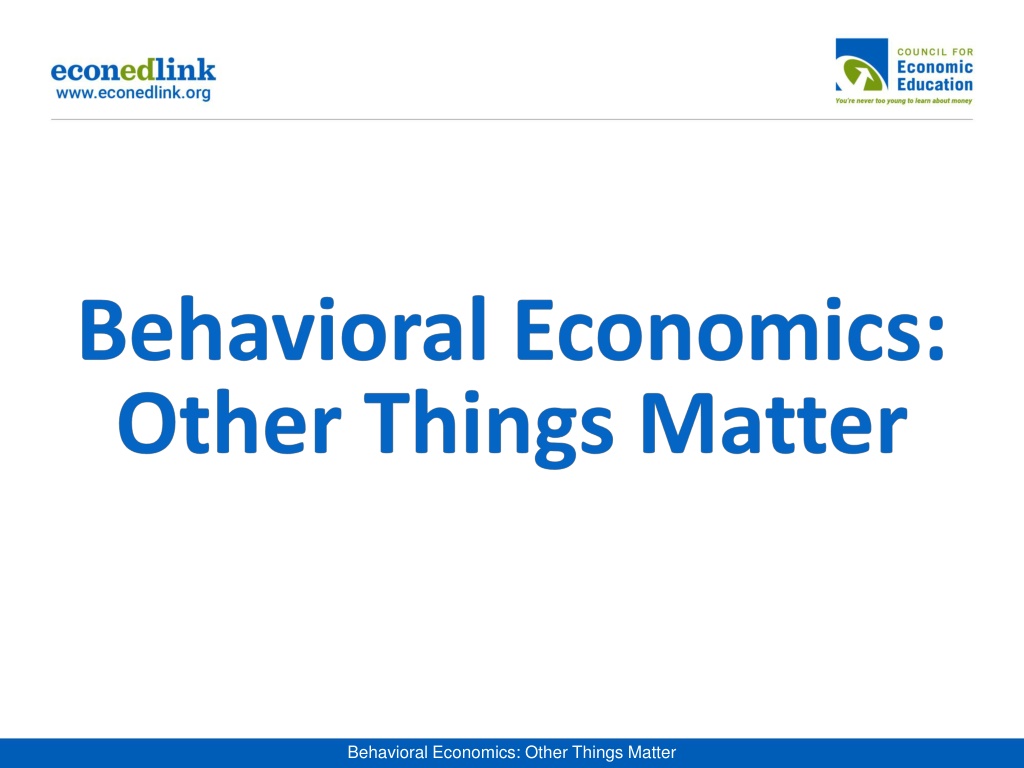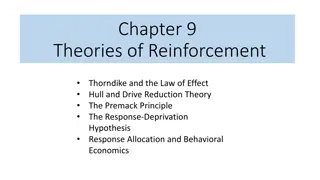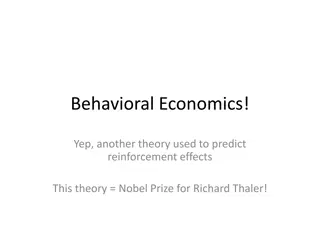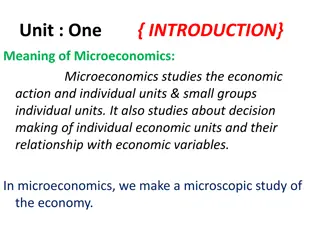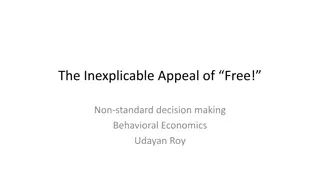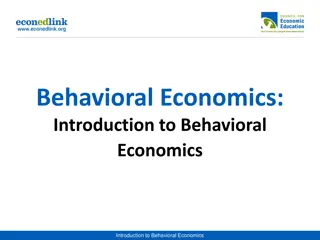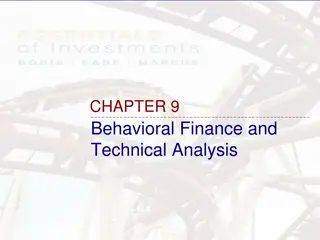Understanding Behavioral Economics in Decision-Making
Explore the dynamics of decision-making in behavioral economics, where individuals are tasked with allocating rewards and responding to offers based on their preferences. Dive into the nuances of proposing and accepting or rejecting offers, highlighting the interplay between self-interest and social considerations.
Download Presentation

Please find below an Image/Link to download the presentation.
The content on the website is provided AS IS for your information and personal use only. It may not be sold, licensed, or shared on other websites without obtaining consent from the author. Download presentation by click this link. If you encounter any issues during the download, it is possible that the publisher has removed the file from their server.
E N D
Presentation Transcript
Every person who makes more than $500,000 in annual income should be required to donate at least 5% of their income to charity. Behavioral Economics: Other Things Matter
You have been assigned a number. Be sure to keep this number. Write your assigned number on the top right-hand corner of your Proposer s Offer Sheet. This number will be used to make sure that you get your offer sheet back. You have been given 10 units of a reward. It is your job to allocate the reward between yourself and another student, the Responder. You are free to offer any amount between 0 and 10 to the Responder. You will keep the rest. The amount offered must be in whole numbers. Behavioral Economics: Other Things Matter
Record your allocation under the Proposers Offer column for Round 1 on your Offer Sheet. Once you have written down your offer, raise your hand so that your proposal can be handed to a Responder. Once all of the Responders have recorded their decision, you will get your Offer Sheet back to see whether your Responder accepted or rejected your offer. In the third column of your Offer Sheet (Total Number of Rewards) fill in the total rewards for the Proposer and the Responder based on the Responder s action. Behavioral Economics: Other Things Matter
A Proposer has been given 10 units of a reward and asked to propose an allocation of that reward between the two of you. Your role is to either accept or reject the offer that you receive from your Proposer. You will be offered an amount between 0 and 10. If you accept the Proposer s offer, you and the Proposer will get the allocation of the reward proposed. If you reject the offer, both of you will receive no reward. Behavioral Economics: Other Things Matter
Read the offer on the Proposers Offer Sheet you are given and decide whether to accept or reject the offer. Write the decision on the Proposer s Offer Sheet. On your Responder s Summary Sheet, record the number of the Proposer that made you the offer, the offer that you received from the Proposer, and whether you accepted or rejected the offer in Round 1. Once you have made your decision, raise your hand so that the Proposer s Offer Sheet can be collected. Behavioral Economics: Other Things Matter
If the Responder rejects the Proposers offer, neither the Proposer nor the Responder will receive any reward. Behavioral Economics: Other Things Matter
Proposers: Did anyone have a first round offer rejected? What changes, if any, did you make in the second round? Proposers: Did you feel compelled to offer more in the second round? Why or why not? Responders: Did anyone reject an offer in the first round? Why? Responders: Did anyone accept less than half of the total in the first round? Why? What should Proposers offer if they want to maximize their own benefits? What are Responders giving up if they reject an offer of only 1 out of the 10 rewards? What do they gain? Behavioral Economics: Other Things Matter
The Ultimatum Game has been conducted by many researchers. Some commonly produced results include: The average split is 60% of the total reward for the Proposer and 40% for the Responder. A 50/50 split is the most common offer. About 20% of low offers (any offer below 50%) are rejected. Behavioral Economics: Other Things Matter
Behavioral economists study and analyze how economic decision making is driven by psychological, emotional, social, and cognitive factors. They bring psychology and decision making together. Behavioral economists like to use the terms Econ and Human to refer to the different ways people make decisions. Econs weigh the costs and benefits of alternatives before making their choices. Humans also use costs and benefits but can be influenced by other factors when making choices. Behavioral Economics: Other Things Matter
Econs Lesson Humans Carefully weigh costs and benefits to make decisions. Make decisions on past experience or quick judgments. 1 Are subject to cognitive biases when making decisions and so may use anchors and fall into relativity traps. Are not subject to cognitive biases when making decisions. 2 Make decisions by weighing costs and benefits equally. 3 Tend to weigh losses greater than gains. Are not influenced by their current situation when making decisions. Tend to bias to the default or to things they already have. 4 May have self-control problems and discount the future too much or be subject to present bias, causing inconsistent decisions. May discount costs and benefits that occur in the future. 5 May make decisions based on fairness or for other emotional factors such as whether work is meaningful. Rely on costs and benefits to make decisions. 6 Behavioral Economics: Other Things Matter
The Meaningful Group The Sisyphus Group Average number of Bionicles built 10.6 7.2 Average earnings $14.40 $11.52 Median wage at which subjects stopped working $1.01 $1.40 Fraction of subjects who continued to work at a wage of <$1.00 65% 20% Kamenica, Emir, Dan Ariely, and Drazen Prelec. "Man's Search for Meaning: The Case of Legos." Journal of Economic Behavior & Organization (2005): n. pag. Web. 05 Dec. 2015 Information of the Sisyphus Group: This condition in the experiment was named after the mythical figure Sisyphus, whom The gods had condemned to ceaselessly rolling a rock to the top of a mountain, whence the stone would fall back of its own weight. They had thought with some reason that there is no more dreadful punishment than futile and hopeless labor. (Albert Camus. "The Myth of Sisyphus." The Myth of Sisyphus. N.p., n.d. Web. 17 Jan. 2016.) Behavioral Economics: Other Things Matter
People make decisions based on: Incentives Monetary Emotional Recognition Costs versus benefits Self interest Presentation of the information (framing) Behavioral Economics: Other Things Matter
